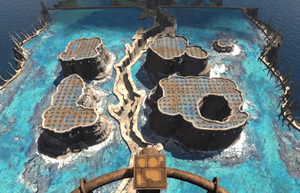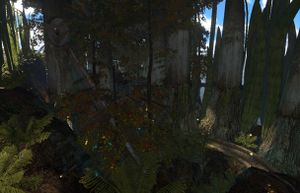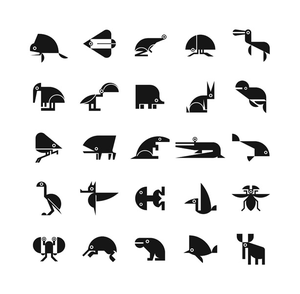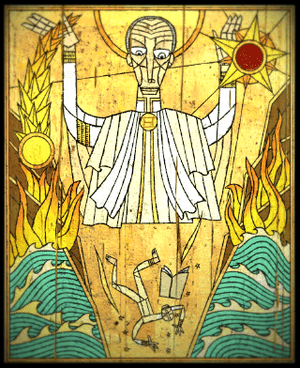Difference between revisions of "Riven"
(added navbox) |
|||
| (30 intermediate revisions by 4 users not shown) | |||
| Line 1: | Line 1: | ||
| − | |||
{{needs-organization}} | {{needs-organization}} | ||
{{for|the game by Cyan|Riven (game)}} | {{for|the game by Cyan|Riven (game)}} | ||
| Line 5: | Line 4: | ||
| name = Riven | | name = Riven | ||
| image = Riven-village.jpg | | image = Riven-village.jpg | ||
| + | | link-ins = Fissure Plateau, Fire Marble Domes | ||
| author = [[Gehn]] | | author = [[Gehn]] | ||
| − | | connections = [[Age 233]] | + | | connections = *[[Age 233]] |
| + | *[[Tay]] | ||
| + | *the [[Cleft]] (Earth) | ||
}} | }} | ||
| − | '''Riven''' was the fifth [[Age]] written by [[Gehn]]. | + | '''Riven''' was the fifth [[Age]] written by [[Gehn]]. All of Gehn's ages were unstable, and though Riven was no exception, it was one of his more successful attempts. Gehn was imprisoned on Riven by his son [[Atrus]] for 33 years. During that time, he appointed himself God of the [[Rivenese]] people, and radically altered the landscape with his own buildings and infrastructure. The people of Riven split into two opposing groups: those who followed Gehn, and the [[Moiety]] who opposed Gehn. |
| − | Riven's | + | During the time of Gehn's imprisonment, Riven's condition began to worsen considerably. Atrus attempted to stabilize the Age by writing corrections in its [[Descriptive Book]], but he was only staving off the inevitable. Riven's collapse was hastened by the [[Star Fissure]], a rift between Ages that formed on the island as a result of changes made in the Descriptive Book. Gehn kept the fissure covered for many years, but when it was uncovered by the [[stranger]], it triggered the Age's immediate and total collapse. |
| − | == | + | ==Appearance== |
| − | ''' | + | Riven had a tropical island climate. Originally it contained a single large island with sandy lagoons, large thick palm trees dotting the coasts, and a lush jungle in the island's interior. One tree grew much taller than all the rest, and was known as Riven's '''Great Tree'''. There is evidence that Riven paid host to a large variety of animal species as well. However, as the age continued to deteriorate, the island split into five separate islands, and many of these animal species went extinct or became scarce. Gehn also cut down much of the jungle in order to make [[book]]s, and devastated much of the natural beauty of the Age with his own structures and machinery. |
| − | '''[[ | + | ===The Islands=== |
| + | [[File:Riven_islands_catherine.jpg|thumb|Sketch of four of the five Riven islands from [[Catherine]]'s journal.]] | ||
| + | [[File:Survey_island_schematic.png|thumb|A schematic map of the five islands. Clockwise from the upper left, Book Assembly Island, Temple Island, Prison Island, Jungle Island, Survey Island.]] | ||
| + | '''[[Temple Island]]''' was the site of [[Temple of Gehn|Gehn's Temple]], and contained the original link-in point for Riven. The most prominent feature on this island however was the [[Golden Superdome]], which generated power for Gehn's faulty [[book|linking books]]. Temple Island was the site of the final battle between [[Atrus]] and [[Gehn]], and was where the [[Star Fissure]] could be found. The Rivenese villagers called the island ''Allapo'' or "water pool", and to the Moiety called it ''Allatwan'' or "pool of stars") | ||
| − | '''[[ | + | '''[[Jungle Island]]''' was the one island that belonged to the Rivenese population after Gehn claimed the other islands for himself. The Rivenese village was located around a lake, along with a schoolhouse and a gallows that Gehn used to exert his power over the villagers. Also on the island was a lush jungle, and a sandy lagoon. |
| − | '''[[ | + | '''[[Book Assembly Island]]''' (also known as '''Crater Island''' or '''Boiler Island''') appeared to be an extinct or dormant volcano. A sulphur-rich lake at the center provided power for the various components of Gehn's bookmaking infrastructure. Gehn built his lab on this island, from which he carried out his bookmaking experiments, and studied the properties of the Age he was trapped on. |
| − | '''[[ | + | '''[[Survey Island]]''' or '''Plateau Island''', arguably the most menacing of the five islands, was the island from which Gehn watched and surveyed the rest of the age. Here he kept various [[Wahrk]]s as pets, and monitored Jungle Island's lake and Prison Island's prison. The design of the island appears to have been intended to reinforce the notion of Gehn's power and godhood, as evidenced by the rows of Wahrk tusks, and the monumental [[Wahrk Throne Room]] found on the lower level. |
| + | |||
| + | '''[[Prison Island]]''' was the smallest of the five islands, and formally the site of Riven's Great Tree. By the time of Riven's collapse, Prison Island had drifted so far away that it could not be seen from the other islands, and it could only be accessed via [[linking book]]. Gehn built a prison cell atop the stump of the Great Tree, and it was here that he imprisoned [[Catherine]]. | ||
===Plant life=== | ===Plant life=== | ||
| − | + | [[File:Jungle Island.jpg|thumb|The jungle.]] | |
| + | Riven was home to a lush tropical jungle in which a number of plant species thrived. The jungle was comprised of large thick trunked trees which covered the sky with yellow leaves. The coverage of leaves was so thick that most of the jungle floor was dark. In the shadow of the trees grew a variety of ferns, lichens, and large fungi including [[Rivenese brown mushroom| large brown mushrooms]] and [[Rivenese glowing mushroom|blue phosphorescent mushrooms]]. Large blades of grass, about 15 feet tall or so also dotted the edges of the jungle. Pools of water lined the jungle floor at parts, which glowed bright cyan, possibly due to some variety of bioluminescent algae. It is known that the Rivenese villagers ate fruit harvested from the brown mushrooms. | ||
| + | |||
| + | The trees of the jungle were very large, but also rather short compared to the thickness of their trunks. They had thick brown bark that covered about sixth of their trunks, after which their trunks seemed bare, or else covered in a lighter-colored bark. Their branches reached outwards all at about the same height, and produced thick yellow leaves. Many of these trees were cut down by [[Gehn]] in order to produce books. The Great Tree which was once on [[Prison Island]] was probably similar to these trees, only significantly bigger. | ||
| − | + | In the lake on Jungle Island, a variety of underwater vegetation could be found including colorful lichen, algae, and seaweed. These aquatic plants seemed to be perfectly adapted to Riven's atypical water. | |
| − | + | Large rounded palm trees also dotted the coasts of the islands. They were most prominently found in the Lagoon and [[Temple Island]]. | |
===Animal life=== | ===Animal life=== | ||
| − | + | [[File:Riven animal symbols.png|thumb|Moiety animal symbols]] | |
| + | The symbols on the [[Moiety caves|standing stones]] used to access [[Tay]] suggest that Riven was host to a wide array of creatures. However, only a few of these have been seen. It's likely that many of these animals had gone extinct by the time of Riven's collapse. | ||
| + | |||
| + | The [[Wahrk]] was a large fish that held a great importance to the Rivenese. Before the arrival of Gehn, they respected and feared the Wahrk, as it was the most powerful force they knew. Gehn took advantage of their reverence for the fish by co-opting its likeness to use as an instrument of terror. | ||
| + | |||
| + | The Rivenese subsisted mainly on fish, and meat from [[Sunner]]s, an aquatic mammal that was hunted nearly to extinction. [[Ytram]]s were poisonous frogs that the Moiety used to make poison darts. [[Scarab]] beetles could be found in the jungle, and were likely similar to beetles found in other D'ni ages, as they were an ingredient of the [[ink]] used to write [[book]]s. | ||
===Water=== | ===Water=== | ||
{{main|Rivenese water}} | {{main|Rivenese water}} | ||
| − | The water of Riven exhibited strange properties | + | The water of Riven exhibited strange properties. Though appearing similar to water in other ages, Rivenese water was repelled by heat. Entire bodies of water would move and bend away from a heat source. This occurred naturally in places where bodies of water came into contact with volcanic vents, but [[Gehn]] also took advantage of it by building tunnels through water out of heating coils. Gehn's research into this phenomena suggested that the movement was enabled by unicellular bacteria living in the water which would die at high temperatures. Digesting Riven's water in its natural, unboiled state results in choking and stomach trouble, and so the Rivenese villagers developed a powder to neutralize the effect. |
===Transportation=== | ===Transportation=== | ||
| − | + | When the main island of Riven broke apart, bridges were built to connect the new islands. (most notably the [[East Path]])<ref>RAWA, "[https://web.archive.org/web/20130619011851/http://cho.cyan.com/RAWA/eastpath/eastpath.html What happened to the East Path?]", The Pages of RAWA, accessed on December 1, 2019.</ref> However, the islands continued to drift and so the bridges kept breaking and had to be repaired. Gehn's solution was to replace the bridges with a [[maglev]] system. The maglev was a tram-like vehicle which ran suspended from a pair of metal cables which it levitated over. The cables were flexible and could be replaced and expanded more easily than the bridges. By the time of Riven's collapse, only the bridge connecting [[Temple Island]] to [[Book Assembly Island]] remained, as these two islands hadn't drifted as far from each other. | |
| + | |||
| + | After Gehn succeeded in writing a link to [[Age 233]], he mostly used linking books to get around the islands. Gehn's books were faulty and needed to be powered, so he built a series of [[firemarble dome]]s to power his books. A small dome was built on each island, and each contained a linking book to [[Age 233]], where he kept books for each of the five islands of Riven. | ||
| + | |||
| + | ===The Number Five=== | ||
| + | [[Gehn]] held some powerful misconceptions over the significance of the number five as it pertained to [[D'ni (race)|D'ni]] culture. He believed that the number five held special power, and that his fifth age embodied this principle. The number five did manifest in Riven in various ways however, such as the number of pieces the island ultimately broke into. Gehn based most of his architecture and engineering around the number five, such as by building five-sided buildings and using five-sided bolts. | ||
| + | |||
| + | ==History== | ||
| + | ===The Fifth Age of Gehn=== | ||
| + | [[Gehn]] grew up during the [[fall of D'ni]] and spent his adult life obsessed with the idea of reviving the culture and traditions of his people. With no [[D'ni (race)|D'ni people]] to teach him, Gehn was left with a twisted idea of what D'ni culture meant. Gehn's method of Writing involved copying and pasting from other [[book]]s, which resulted in [[Age]]s that were unstable. He believed that the Ages written in Descriptive Books were Created by the writer, which made the writer God, and that he therefore had the authority to do whatever he wanted with his own Ages and their inhabitants. | ||
| − | + | Gehn didn't give his Fifth Age a name. Like all of his ages, he only ever referred to it by number, but its inhabitants called it '''Riven'''. Riven along with several of Gehn's other ages such as [[Age 37]]{{citation needed}} served as training grounds to teach non-D'ni the [[Art]]. Gehn established a skeleton of the '[[Guild of Writers]]', beginning to teach [[Rivenese]] natives how to write in [[D'ni language|D'ni]] and construct Ages. The members of this Guild were branded on their necks with Gehn's symbol and elevated above the rest of the Rivenese. Gehn's most notable student was [[Catherine]], who quickly excelled beyond what Gehn could teach her. However, he exhibited a callous disregard for the people and culture of Riven. | |
| − | == | + | ===The Battle at the Fissure=== |
| − | + | [[File:Gate room image 1.png|thumb|[[Atrus]] plunges into the [[Star Fissure]], leaving [[Gehn]] trapped on Riven.]] | |
| + | In order to halt Gehn's destructive path across other Ages, his son [[Atrus]] trapped Gehn on Riven by removing all books from the Age. During the climactic battle, Catherine wrote various changes into Riven's descriptive book to provide Atrus an opportunity to safely escape. These changes included numerous volcanic fissures, a solar eclipse, and the sudden appearance of [[Riven daggers|five giant daggers]]. The daggers would remain until Riven's final days, and one of them became [[Moiety dagger|the symbol]] of resistance against Gehn. A consequence of these changes was the [[Star Fissure]] that appeared on what later became [[Temple Island]]. The Star Fissure was a rift between Ages, and likely a manifestation of Riven's instabilities. When Atrus flung the last linking book into the fissure, Gehn was at last trapped on Riven. The Age of Riven was always unstable and doomed to die, but the Star Fissure hastened the Age's inevitable collapse. | ||
| − | + | ===Gehn's Banishment=== | |
| + | Once trapped on Riven, Gehn took his place as God of the Rivenese people. He reshaped the Age to his own ends. Abandoning his earlier plan to teach the Rivenese something of the Art, he established five new guilds: Bookmakers, Builders, Educators, Maintainers, and Surveyors. Gehn spent many years re-creating the Art, and mobilizing Riven's resources to create [[book]]s and [[ink]]. He ruled the Age by way of terror and brute force, but a group of Rivenese who had witnessed the battle at the Fissure formed a group called the [[Moiety]] to fight back. Thus, the Rivenese people became divided into those who followed Gehn, and those who resisted. | ||
| − | ===Riven | + | ===The Collapse of Riven=== |
| − | Among the numerous instabilities of Riven were "the structure of the tectonic plates beneath the planet's crust, the type and strength of the oceanic currents, fluctuations in gravitational fields, and the composition of the crust..."<ref>[[Book of Atrus]], chapter 21, paperback edition p. 352–353</ref> | + | Riven was doomed to collapse before Gehn ever set foot on it, because the Descriptive Book contained too many contradictions. Among the numerous instabilities of Riven were "the structure of the tectonic plates beneath the planet's crust, the type and strength of the oceanic currents, fluctuations in gravitational fields, and the composition of the crust..."<ref>[[Book of Atrus]], chapter 21, paperback edition p. 352–353</ref> Riven's moon had an orbit low enough that great tides would eventually drown the island. Ultimately the moon would collide with the planet. Atrus wrote corrections into the Descriptive Book which corrected the most severe flaws temporarily, but his fixes began to fail around the time of Catherine's return to Riven. |
| − | The final demise of Riven came | + | The [[Star Fissure]] accelerated the age's collapse. In its final years, the island split into five separate islands and began drifting further and further apart. The final demise of Riven came when the Star Fissure was re-opened. The entire age{{contested|reason=The final fate of Riven is purely speculative}} collapsed into the void between ages. Just before the collapse, Catherine succeeded in relocating the people of Riven to [[Tay]]. |
| − | + | ===Aftermath=== | |
| + | [[File:Riven_descriptive_book.jpg|thumb|The Riven descriptive book in [[Tomahna]].]] | ||
| + | The [[Descriptive Book]] for Riven was kept in Atrus's study in [[Tomahna]], following the destruction of the Age. The book no longer functioned, and its linking panel displayed a swirling mass of color and light. It's not known whether the book survived the fire caused by [[Saavedro]]. Its condition and current whereabouts are unknown. The inhabitants of Riven thrived in their new home [[Tay]]. [[Catherine]] brought the book for Tay with her before leaving Riven, and would sometimes visit her people. A couple remnants of Riven which fell through the fissure can now be found on [[Earth]] near the [[Cleft]]. The remains of the Fissure telescope, and a skeleton of a [[Wahrk]] lie in the middle of the New Mexico desert. The [[Riven daggers|Fissure dagger]] which inspired the [[Moiety]] emblem now lies in the [[Volcano]]. | ||
==External links== | ==External links== | ||
| Line 67: | Line 95: | ||
[[Category:Inhabited Ages]] | [[Category:Inhabited Ages]] | ||
[[Category:Ages appearing in Riven]] | [[Category:Ages appearing in Riven]] | ||
| + | [[Category:Ages written by Gehn]] | ||
Latest revision as of 02:01, 24 July 2023
This article may be in need of reorganization to comply with the Archive's layout guidelines. |
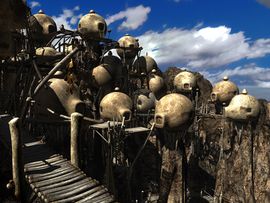 | |
| Author | Gehn |
|---|---|
| Link-in points | Fissure Plateau, Fire Marble Domes |
| Connections | |
Riven was the fifth Age written by Gehn. All of Gehn's ages were unstable, and though Riven was no exception, it was one of his more successful attempts. Gehn was imprisoned on Riven by his son Atrus for 33 years. During that time, he appointed himself God of the Rivenese people, and radically altered the landscape with his own buildings and infrastructure. The people of Riven split into two opposing groups: those who followed Gehn, and the Moiety who opposed Gehn.
During the time of Gehn's imprisonment, Riven's condition began to worsen considerably. Atrus attempted to stabilize the Age by writing corrections in its Descriptive Book, but he was only staving off the inevitable. Riven's collapse was hastened by the Star Fissure, a rift between Ages that formed on the island as a result of changes made in the Descriptive Book. Gehn kept the fissure covered for many years, but when it was uncovered by the stranger, it triggered the Age's immediate and total collapse.
Contents
Appearance[edit]
Riven had a tropical island climate. Originally it contained a single large island with sandy lagoons, large thick palm trees dotting the coasts, and a lush jungle in the island's interior. One tree grew much taller than all the rest, and was known as Riven's Great Tree. There is evidence that Riven paid host to a large variety of animal species as well. However, as the age continued to deteriorate, the island split into five separate islands, and many of these animal species went extinct or became scarce. Gehn also cut down much of the jungle in order to make books, and devastated much of the natural beauty of the Age with his own structures and machinery.
The Islands[edit]
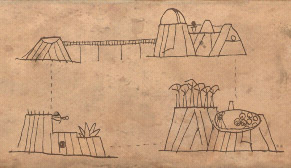
Temple Island was the site of Gehn's Temple, and contained the original link-in point for Riven. The most prominent feature on this island however was the Golden Superdome, which generated power for Gehn's faulty linking books. Temple Island was the site of the final battle between Atrus and Gehn, and was where the Star Fissure could be found. The Rivenese villagers called the island Allapo or "water pool", and to the Moiety called it Allatwan or "pool of stars")
Jungle Island was the one island that belonged to the Rivenese population after Gehn claimed the other islands for himself. The Rivenese village was located around a lake, along with a schoolhouse and a gallows that Gehn used to exert his power over the villagers. Also on the island was a lush jungle, and a sandy lagoon.
Book Assembly Island (also known as Crater Island or Boiler Island) appeared to be an extinct or dormant volcano. A sulphur-rich lake at the center provided power for the various components of Gehn's bookmaking infrastructure. Gehn built his lab on this island, from which he carried out his bookmaking experiments, and studied the properties of the Age he was trapped on.
Survey Island or Plateau Island, arguably the most menacing of the five islands, was the island from which Gehn watched and surveyed the rest of the age. Here he kept various Wahrks as pets, and monitored Jungle Island's lake and Prison Island's prison. The design of the island appears to have been intended to reinforce the notion of Gehn's power and godhood, as evidenced by the rows of Wahrk tusks, and the monumental Wahrk Throne Room found on the lower level.
Prison Island was the smallest of the five islands, and formally the site of Riven's Great Tree. By the time of Riven's collapse, Prison Island had drifted so far away that it could not be seen from the other islands, and it could only be accessed via linking book. Gehn built a prison cell atop the stump of the Great Tree, and it was here that he imprisoned Catherine.
Plant life[edit]
Riven was home to a lush tropical jungle in which a number of plant species thrived. The jungle was comprised of large thick trunked trees which covered the sky with yellow leaves. The coverage of leaves was so thick that most of the jungle floor was dark. In the shadow of the trees grew a variety of ferns, lichens, and large fungi including large brown mushrooms and blue phosphorescent mushrooms. Large blades of grass, about 15 feet tall or so also dotted the edges of the jungle. Pools of water lined the jungle floor at parts, which glowed bright cyan, possibly due to some variety of bioluminescent algae. It is known that the Rivenese villagers ate fruit harvested from the brown mushrooms.
The trees of the jungle were very large, but also rather short compared to the thickness of their trunks. They had thick brown bark that covered about sixth of their trunks, after which their trunks seemed bare, or else covered in a lighter-colored bark. Their branches reached outwards all at about the same height, and produced thick yellow leaves. Many of these trees were cut down by Gehn in order to produce books. The Great Tree which was once on Prison Island was probably similar to these trees, only significantly bigger.
In the lake on Jungle Island, a variety of underwater vegetation could be found including colorful lichen, algae, and seaweed. These aquatic plants seemed to be perfectly adapted to Riven's atypical water.
Large rounded palm trees also dotted the coasts of the islands. They were most prominently found in the Lagoon and Temple Island.
Animal life[edit]
The symbols on the standing stones used to access Tay suggest that Riven was host to a wide array of creatures. However, only a few of these have been seen. It's likely that many of these animals had gone extinct by the time of Riven's collapse.
The Wahrk was a large fish that held a great importance to the Rivenese. Before the arrival of Gehn, they respected and feared the Wahrk, as it was the most powerful force they knew. Gehn took advantage of their reverence for the fish by co-opting its likeness to use as an instrument of terror.
The Rivenese subsisted mainly on fish, and meat from Sunners, an aquatic mammal that was hunted nearly to extinction. Ytrams were poisonous frogs that the Moiety used to make poison darts. Scarab beetles could be found in the jungle, and were likely similar to beetles found in other D'ni ages, as they were an ingredient of the ink used to write books.
Water[edit]
The water of Riven exhibited strange properties. Though appearing similar to water in other ages, Rivenese water was repelled by heat. Entire bodies of water would move and bend away from a heat source. This occurred naturally in places where bodies of water came into contact with volcanic vents, but Gehn also took advantage of it by building tunnels through water out of heating coils. Gehn's research into this phenomena suggested that the movement was enabled by unicellular bacteria living in the water which would die at high temperatures. Digesting Riven's water in its natural, unboiled state results in choking and stomach trouble, and so the Rivenese villagers developed a powder to neutralize the effect.
Transportation[edit]
When the main island of Riven broke apart, bridges were built to connect the new islands. (most notably the East Path)[1] However, the islands continued to drift and so the bridges kept breaking and had to be repaired. Gehn's solution was to replace the bridges with a maglev system. The maglev was a tram-like vehicle which ran suspended from a pair of metal cables which it levitated over. The cables were flexible and could be replaced and expanded more easily than the bridges. By the time of Riven's collapse, only the bridge connecting Temple Island to Book Assembly Island remained, as these two islands hadn't drifted as far from each other.
After Gehn succeeded in writing a link to Age 233, he mostly used linking books to get around the islands. Gehn's books were faulty and needed to be powered, so he built a series of firemarble domes to power his books. A small dome was built on each island, and each contained a linking book to Age 233, where he kept books for each of the five islands of Riven.
The Number Five[edit]
Gehn held some powerful misconceptions over the significance of the number five as it pertained to D'ni culture. He believed that the number five held special power, and that his fifth age embodied this principle. The number five did manifest in Riven in various ways however, such as the number of pieces the island ultimately broke into. Gehn based most of his architecture and engineering around the number five, such as by building five-sided buildings and using five-sided bolts.
History[edit]
The Fifth Age of Gehn[edit]
Gehn grew up during the fall of D'ni and spent his adult life obsessed with the idea of reviving the culture and traditions of his people. With no D'ni people to teach him, Gehn was left with a twisted idea of what D'ni culture meant. Gehn's method of Writing involved copying and pasting from other books, which resulted in Ages that were unstable. He believed that the Ages written in Descriptive Books were Created by the writer, which made the writer God, and that he therefore had the authority to do whatever he wanted with his own Ages and their inhabitants.
Gehn didn't give his Fifth Age a name. Like all of his ages, he only ever referred to it by number, but its inhabitants called it Riven. Riven along with several of Gehn's other ages such as Age 37[citation needed] served as training grounds to teach non-D'ni the Art. Gehn established a skeleton of the 'Guild of Writers', beginning to teach Rivenese natives how to write in D'ni and construct Ages. The members of this Guild were branded on their necks with Gehn's symbol and elevated above the rest of the Rivenese. Gehn's most notable student was Catherine, who quickly excelled beyond what Gehn could teach her. However, he exhibited a callous disregard for the people and culture of Riven.
The Battle at the Fissure[edit]
In order to halt Gehn's destructive path across other Ages, his son Atrus trapped Gehn on Riven by removing all books from the Age. During the climactic battle, Catherine wrote various changes into Riven's descriptive book to provide Atrus an opportunity to safely escape. These changes included numerous volcanic fissures, a solar eclipse, and the sudden appearance of five giant daggers. The daggers would remain until Riven's final days, and one of them became the symbol of resistance against Gehn. A consequence of these changes was the Star Fissure that appeared on what later became Temple Island. The Star Fissure was a rift between Ages, and likely a manifestation of Riven's instabilities. When Atrus flung the last linking book into the fissure, Gehn was at last trapped on Riven. The Age of Riven was always unstable and doomed to die, but the Star Fissure hastened the Age's inevitable collapse.
Gehn's Banishment[edit]
Once trapped on Riven, Gehn took his place as God of the Rivenese people. He reshaped the Age to his own ends. Abandoning his earlier plan to teach the Rivenese something of the Art, he established five new guilds: Bookmakers, Builders, Educators, Maintainers, and Surveyors. Gehn spent many years re-creating the Art, and mobilizing Riven's resources to create books and ink. He ruled the Age by way of terror and brute force, but a group of Rivenese who had witnessed the battle at the Fissure formed a group called the Moiety to fight back. Thus, the Rivenese people became divided into those who followed Gehn, and those who resisted.
The Collapse of Riven[edit]
Riven was doomed to collapse before Gehn ever set foot on it, because the Descriptive Book contained too many contradictions. Among the numerous instabilities of Riven were "the structure of the tectonic plates beneath the planet's crust, the type and strength of the oceanic currents, fluctuations in gravitational fields, and the composition of the crust..."[2] Riven's moon had an orbit low enough that great tides would eventually drown the island. Ultimately the moon would collide with the planet. Atrus wrote corrections into the Descriptive Book which corrected the most severe flaws temporarily, but his fixes began to fail around the time of Catherine's return to Riven.
The Star Fissure accelerated the age's collapse. In its final years, the island split into five separate islands and began drifting further and further apart. The final demise of Riven came when the Star Fissure was re-opened. The entire age[contested] collapsed into the void between ages. Just before the collapse, Catherine succeeded in relocating the people of Riven to Tay.
Aftermath[edit]
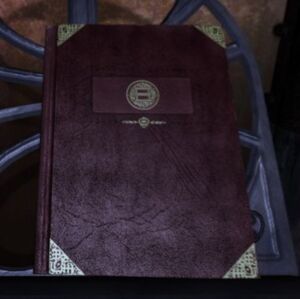
The Descriptive Book for Riven was kept in Atrus's study in Tomahna, following the destruction of the Age. The book no longer functioned, and its linking panel displayed a swirling mass of color and light. It's not known whether the book survived the fire caused by Saavedro. Its condition and current whereabouts are unknown. The inhabitants of Riven thrived in their new home Tay. Catherine brought the book for Tay with her before leaving Riven, and would sometimes visit her people. A couple remnants of Riven which fell through the fissure can now be found on Earth near the Cleft. The remains of the Fissure telescope, and a skeleton of a Wahrk lie in the middle of the New Mexico desert. The Fissure dagger which inspired the Moiety emblem now lies in the Volcano.
External links[edit]
- Calyxa's Cartography, with detailed maps of the islands of Riven.
- Another map of Riven that came with Prima's Secrets of the Games' Riven: Strategy Guide (1997).
References[edit]
- ↑ RAWA, "What happened to the East Path?", The Pages of RAWA, accessed on December 1, 2019.
- ↑ Book of Atrus, chapter 21, paperback edition p. 352–353
